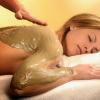CYBERMED LIFE - ORGANIC & NATURAL LIVING
CYBERMED LIFE - ORGANIC & NATURAL LIVING
 Mud therapy: A mud bath is a bath of mud, commonly from areas where hot spring water can combine with volcanic ash. Mud baths have existed for thousands of years, and can be found now in high-end spas in many countries of the world.
Mud therapy: A mud bath is a bath of mud, commonly from areas where hot spring water can combine with volcanic ash. Mud baths have existed for thousands of years, and can be found now in high-end spas in many countries of the world.
Mud baths come from many sources:
Mud baths in the United States are mostly found at the resorts in California and Miami Beach, Florida. The mud is a combination of local volcanic ash, imported Canadian peat and naturally heated mineral waters. Historically, the mud bath treatment has been used for centuries in Eastern and Western European spas as a way to relieve arthritis.
In Romania, Lake Techirghiol is famous for treatments with mud baths. The lake's hypersaline environment is due to the successive evaporation of sea water that remained in its basin after a tectono-erosive phase exhaustion created a fluvial-marine firth and the lake's connection to the sea closed. The accumulation of salts in the water is also a result of a semiarid climate with higher temperatures in summer, leading to pronounced evaporation. The lake's higher salinity (83.6 g/l in 1970, and 63.6 gl/l in 1980), in spite of a decrease over time, has been a bottleneck in the selection of the lake animal and plant species.
In Italy, in Lido delle Nazioni at Ferrara offers mud bath therapies. It is claimed that the treatment, which is founded on contact with bromine salt water, has anti-inflammatory, detoxifying, analgesic, relaxing and revitalizing properties.
Mud is an important element of nature. It contains important minerals which have positive effects on human health. Mud can absorb toxins from human body therefore is very useful in preventing many diseases. It is also known for its healing properties. It also helps in cooling and relaxing body as it can hold moisture for a long time.
Benefits of Mud therapy
Why use mud therapy?
Out of the five constituent elements of this universe mud (earth) has a pivotal role to play in our well being. The dark color of mud helps in absorbing different colors and conveying them to the the body, giving it therapeutic properties. Also, its shape and consistency may be modified with ease, just by changing the water content, which makes it easy to use. A mud pack is advantageous over a cold compress (cold water therapy) as it retains the coolness over a longer period of time. Therefore, it is recommended whenever a prolonged cold application is required. Lastly, it is easily available and a cost effective treatment option.
Types of Mud
Mud found in different parts of the world has different properties. Mud composition varies with the place of origin. Firstly, mineral constituents of mud varies with the kind of rocks found in the region and the process of soil formation. Secondly, mud property is influenced by kind of flora and fauna of the region. Therefore, it is essential to learn about properties of mud before utilizing it benefits. It is important to note that before using any type of mud it should be dried, powdered and sieved to remove any type of impurities such as stones, grass, etc.
Black mud: Dark cotton soil having some greasiness is suitable for mud therapy as it is rich in minerals and also retains water for long time. It should always be free from contamination and any kind of pollution.
Mud from Dead Sea: Cleopatra and Queen Sheeba used it for enhancing beauty, black mud of Dead sea has beautifying and therapeutic powers. It is contains more than 20 kinds of salts and minerals including Magnesium, Calcium, Potassium Bromide, Silicates, Natural Tar and organic elements. While these beneficial minerals are useful for healing any kind of skin disorders, the presence of silicates make its masks very beneficial for softening and cleansing skin. The mud enhances blood circulation and leaves the skin with a glow.
Moor Mud: It is mud produced over thousands of years from organic residue of flowers, grasses and herbs. This residue transformed over several years to fine paste which contains fulvic acids, vitamins, amino acids, plant hormones, humic acids in a form which could be easily absorbed by human body. The mud has chelatic properties which enables its top layer to filter out impurities/pollutants and preserve purity of the mud. This mud has therapeutic properties and is useful in detoxification, healing, beautification, nourishing human body. The mud has anti-inflammatory and anti-aging effects. It is also useful in conditions such as Arthritis and recovery from injury in sports.